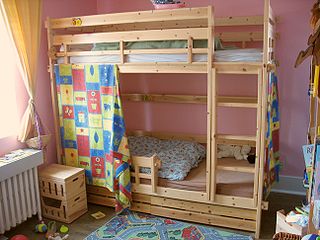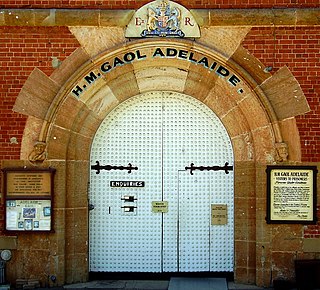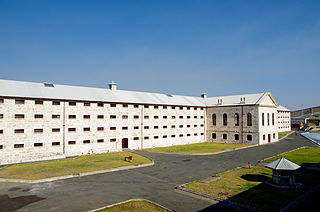
A bunk bed or set of bunks is a type of bed in which one bed frame is stacked on top of another, allowing two or more sleeping-places to occupy the floor space usually required by just one. Bunks are commonly seen on ships, in the military, and in hostels, dormitories, summer camps, children's bedrooms, and prisons.

The Long Bay Correctional Complex, commonly called Long Bay, is a correctional facility comprising a heritage-listed maximum and minimum security prison for males and females and a hospital to treat prisoners, psychiatric cases and remandees, located in Malabar, Sydney, New South Wales, Australia. The complex is located approximately 14 kilometres (8.7 mi) south of the Sydney CBD and is contained within a 32-hectare (79-acre) site. The facility is operated by Corrective Services New South Wales, a department administered by the Government of New South Wales.
Acacia Prison is a medium security prison facility located in Wooroloo, Western Australia. The prison was opened in May 2001.
Karnet Prison Farm is a minimum-security Western Australian prison located in Keysbrook State Forest, 78 kilometres (48 mi) south of Perth, in the Shire of Serpentine-Jarrahdale.

Adelaide Gaol is a former Australian prison located in the Park Lands of Adelaide, in the state of South Australia. The gaol was the first permanent one in South Australia and operated from 1841 until 1988. The Gaol is one of the two oldest buildings still standing in South Australia, the other being Government House which was built at the same time. The prison is now a museum, tourist attraction and function centre.
Hakea Prison is a maximum security prison for males, located in Canning Vale, Western Australia. The facility is managed by the Department of Justice on behalf of the Government of Western Australia.
Greenough Regional Prison is an Australian prison located in Narngulu, a suburb of Geraldton, Western Australia. The prison was opened in 1984 and had an operational capacity of 328 as of November 2012. The prison houses prisoners from around the Mid West region, including a large proportion of Aboriginal prisoners. A mix of maximum (remand), medium and minimum security prisoners are held at Greenough, including 25 female prisoners, with two cells available for mothers and babies and a minimum security facility that houses 36 male prisoners.

Albany Regional Prison is a maximum security prison located 8 km West of Albany, Western Australia. Albany Prison was commissioned in 1966 with a capacity of 72 minimum security cells. In 1979 it was upgraded to maximum security and in 1988 expanded to a capacity of 126. In 1993 it expanded again, to 186 standard-bed cells and by 2013 to 310.

Fremantle Prison, sometimes referred to as Fremantle Gaol or Fremantle Jail, is a former Australian prison and World Heritage Site in Fremantle, Western Australia. The site includes the prison cellblocks, gatehouse, perimeter walls, cottages, and tunnels. It was initially used for convicts transported from Britain, but was transferred to the colonial government in 1886 for use for locally-sentenced prisoners. Royal Commissions were held in 1898 and 1911, and instigated some reform to the prison system, but significant changes did not begin until the 1960s. The government department in charge of the prison underwent several reorganisations in the 1970s and 1980s, but the culture of Fremantle Prison was resistant to change. Growing prisoner discontent culminated in a 1988 riot with guards taken hostage, and a fire that caused $1.8 million worth of damage. The prison closed in 1991, replaced by the new maximum-security Casuarina Prison.
ACT Corrective Services (ACTCS) is an agency of the Justice and Community Safety Directorate (JACSD) of the Australian Capital Territory government in the Australian Capital Territory, Australia. It is responsible for a wide range of activities and services in the area aimed at protecting the community and reducing offending behaviour.
The Metropolitan Remand Centre is an Australian prison located at Ravenhall, Victoria, approximately 20 kilometres from the Melbourne CBD on the Western Freeway. The prison is a maximum security remand facility which opened in April 2006 and is operated by the Victorian Department of Justice and Regulation.

The Perth Gaol was a gaol built in Perth, the state capital of Western Australia, between 1854 and 1856 to house convicts and other prisoners. It is located just west of Beaufort Street.
The Western Australian Prison Officers’ Union (WAPOU) is a registered trade union founded in 1934 in Western Australia. The union represents employees within the prison services, including prison officers of Western Australia. The union is affiliated with the Australian Council of Trade Unions, UnionsWA and the Australian Labor Party (WA). The union is part of the Prison Officers of Australasia organisation, representing prison officers through the region.

HM Prison Brixton used to be a local prison but has been since 2012 a Category C training establishment men's prison, located in Brixton area of the London Borough of Lambeth, in inner-South London. The prison is operated by His Majesty's Prison Service.

The Alexander Maconochie Centre is an Australian prison in the Australian Capital Territory, which detains maximum security, minimum security and remand inmates, both male and female. It is located in Hume, Australian Capital Territory. The facility is operated by ACT Corrective Services, an agency of the Government of the Australian Capital Territory. The facility accepts remandees charged under Territory and/or Commonwealth legislation pending legal proceedings; and also detains convicted offenders who are sentenced to full-time imprisonment.
Corrective Services New South Wales (CSNSW) is a division of the Department of Communities and Justice of the Government of New South Wales, Australia. CSNSW is responsible for the state's prisons and a range of programs for managing offenders in the community. The state has 36 prisons, 33 run by CSNSW and three privately operated. The agency traces its origins back to 1788, when New South Wales was founded as a penal colony.
The history of Fremantle Prison, a former Australian prison in Fremantle, Western Australia, extends from its construction as a prison for convicts, using convict labour, in the 1850s, through to its modern-day usage as a tourist attraction. The design for Fremantle Prison was based on the Pentonville Prison in Britain, and it would be the longest, tallest prison cell block in the southern hemisphere. Construction began in 1851, and was completed by the end of 1859. The prison was transferred to the colonial government in 1886 for use for locally sentenced prisoners. Following a Royal Commission held in 1898−99, some changes were made to Fremantle Prison, including knocking down the inner wall between two cells, introducing a prisoner classification system, and constructing internal walls in the main block to create four separate divisions. A new cell block, New Division, was completed in 1907 and occupied in 1908.

There have been various riots at Fremantle Prison, and other disturbances, over the years that it was operational. Fremantle Prison was built using convict labour during the 1850s, based on the design of Pentonville Gaol, and was used as the maximum security prison for male offenders in Western Australia. While there were some reforms following Royal Commissions in 1898−99 and 1911, significant changes to the operation of Fremantle Prison did not begin until the 1960s. One of the earliest incidents was in 1854, while major riots which occurred in 1968 and 1988 resulted in damage to the prison.
Melaleuca Women's Prison is a maximum security prison for women, in Canning Vale, Western Australia. It opened in December 2016, and has a capacity of 254 inmates. Melaleuca is a standalone facility, built on what were previously Units 11 and 12 of Hakea Prison.










